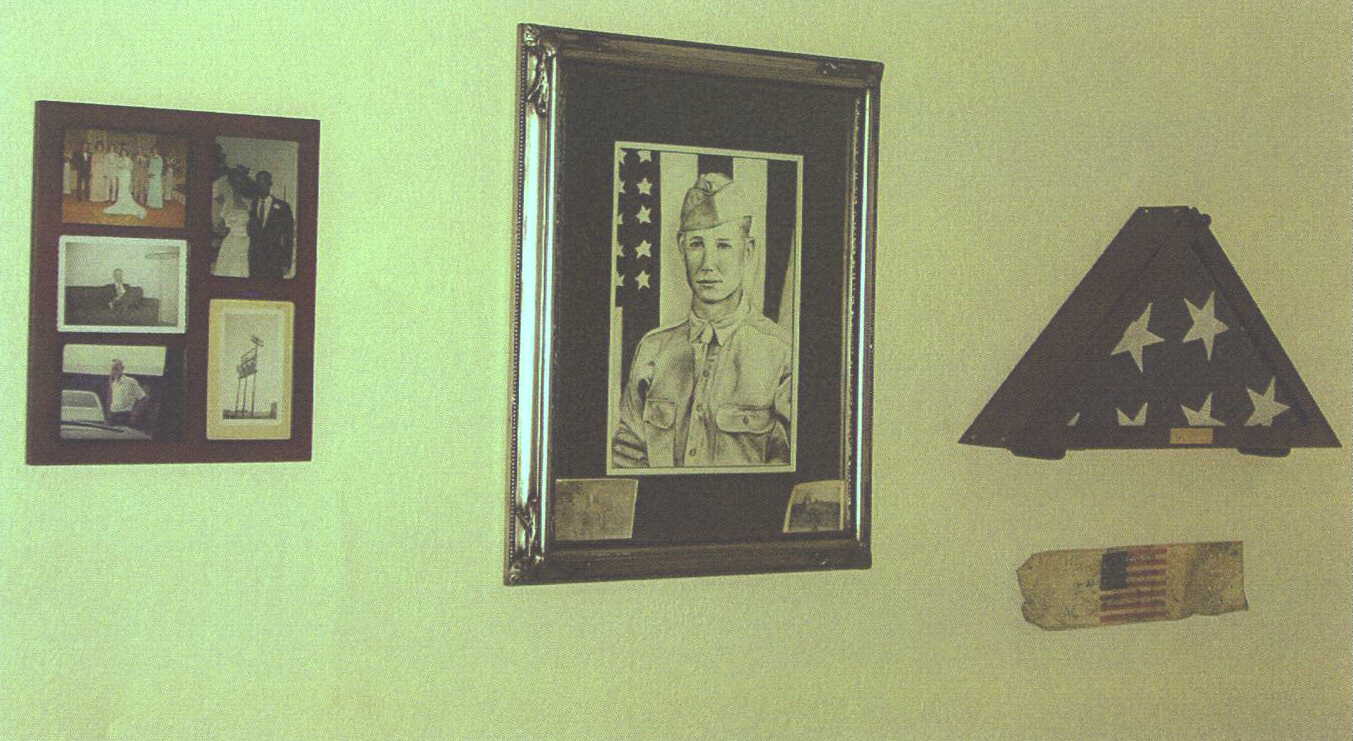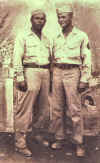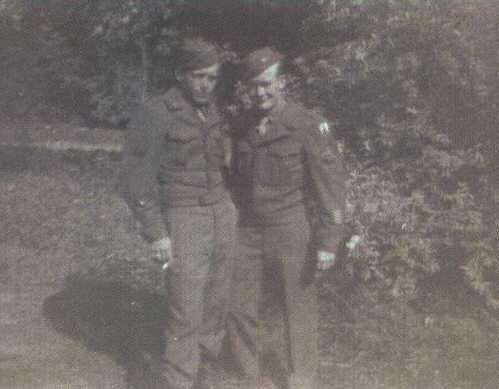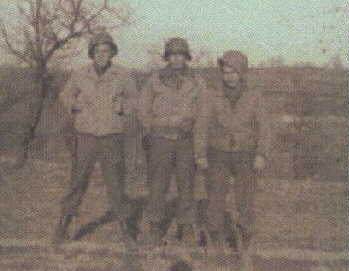WELCOME TO
MITCHELL
COUNTY, TEXAS
The TXGenWeb
Project and The USGenWeb Project
|
WELCOME TO
|
||
A Brief History of the Path
Taken by the 927th Signal Battalion In World War II
By Dale Skelton
September 20, 2003
In memory of James E. "Red"
Skelton, Jr.
And Norman "Chink" Pockrus
With special acknowledgement and honor to W. A. "Bill" Ringener

Picture of Dad drawn by Melody, my oldest daughter.
Photo taken by my youngest daughter, Mandy
(click to enlarge)
| Invasion of North Africa (November 1942):
The invasion of North Africa was designated “Operation Torch”. Red and Bill’s signal company B were with the 3rd Infantry Division. On November 8, 1942, they landed ashore at night at Fedala, which is close to Casablanca. There were no LSTs, LCIs or “ducks” at the landing of Fedala, only big gray transports and their small transport-born landing craft. They climbed down the side of the transport to the landing craft on a rope net. Bill said that it was a bit tricky getting onto the landing craft with it bobbing up and down with the waves; it was easy to misjudge distances; just as you were ready to step onto the craft, it could go up or down a foot or more without warning. Red wrote the following on the back of his armband with a blue marksalot JE Skelton N. Africa Nov 8, 1942 The fighting in Fedala and Casablanca lasted
for 3 days, until the Vichy French, which had originally pledged allegiance to Germany,
asked for a cease-fire and surrendered to the allies.
|

Norman "Chink" Pockrus and Red.
Picture probably taken in Palermo
(click to enlarge)
| Invasion of Sicily (July 1943):
HISTORY: The planned invasion of Sicily, code named Operation Husky, would begin the Allie’s re-entry into Europe. There were several goals for the invasion, which included persuading the Italians to surrender, to maintain a second front that would aid the Russians, and to capture as many German forces as possible before they could withdraw back to Southern Italy. The invasion force was the largest amphibious assault to ever be attempted at that time, and consisted of 3,000 ships that were mainly American and British, but there were also Belgian, Dutch, Greek, Norwegian and Polish ships. The number of men exceeded 160,000. The invasion took place on the planned date of July 10, 1943, when the moon would be at first quarter, and thus there would be very little moonlight. During the initialize phase of the operation, as the fleet was sailing to Sicily, the weather became very rough, with high winds and large swells. The weather died down prior to the landings. The British troops landed on the Southeast side of Sicily while the American troops landed on the South side. The 3rd division landed close to Licata, the 1st division landed close to Gela, and the 45th division landed close to Scoglitti. Bill and Red sailed from Tunisia to Sicily on an LST, and landed on Gela
Beach on July 10. They ended up in Palermo at the end of the Sicilian campaign, which
ended on August 16 when US forces entered Messina. During the Sicilian campaign, Bill
received orders to go to a Command Post with a couple of men and install some
communication systems. When he got to the room on the second floor, he noticed several
generals, one being George Patton. At the end of the campaign, the area around Mount Etna
and Catania were off-limits to Americans; they were being held by the British. Bill
noticed a couple of Americans walking back to camp in British uniforms, and decided that
they must have gone off on a sightseeing tour.
Invasion of Italy (late 1943):
Bill and Red left Sicily in late 1943, and landed in Italy
close to Pompeii, which is close to Naples. They were at different locations through the
winter and summer of 1944, winding up in Rome. One thing Bill remembered about Italy was
the constant working in “mud up to your knees”; it rained continuously
throughout the winter months. During this time, they were located close to the Rapido
River, about 10 miles from Cassino. The battle at the Rapido was very costly for the 36th
division; that attempt to cross the Rapido River was not successful and should have never
been attempted. Many brave men were lost during that battle. The path that Bill and Red
took to Rome was probably through the Liri Valley, located South of Cassino.
|
| Invasion of Southern France (August, 1944):
HISTORY: After Rome was liberated by the Allies in late May 1944, the 3rd, 45th and 36th divisions began planning for the invasion of Southern France, known as Operation Dragoon. The Allied command felt that invading Southern France, at the French Riviera area, would divert German troops from Normandy. The Allies could then form a complete line of advance across France. Capture of several major ports, particularly Marseille (the largest port in France), would help supply the Allied advance. The Germans expected an Allied invasion of Southern France, but an early-August German counterattack in Northern France had failed, and the Germans were desperately trying to get as many men as possible out of the so-called Falaise pocket. The Germans had switched commanders in Northern France twice, plus were suffering from the confusion caused by the July 20 plot to kill Hitler. Their basic plan in the French Riviera would eventually be the same as in Italy - delaying the Allies as much as possible while withdrawing to stronger, mountain-based defense positions. The French Riviera invasion took place on August 15, 1944, around 8:00 in the morning. Daylight was required for accurate bombardment, and the landing forces needed as much daylight as possible to get sufficient troops and supplies ashore, secure the landing - and, having learned the lessons of Salerno and Anzio, capture nearby hills. The landings were very successful. The 3rd division landed at St. Tropez, the 36th landed at Cannes and the 45th landed at St. Maxime. The 3rd division pushed on to the port city of Marseille, while the 45th and the 36th pushed north to Grenoble. The Allies were able to advance up to Besancon, about 300 miles from the invasion landings, in about 1 month. The French resistance fighters aided in the rapid advancement by cutting the German communication lines and disrupting troop movements. Bill and Red left Naples on August 13 on an LCI, passed through the Sardinia-Corsica Straits and arrived offshore of the Riviera beaches, close to the town of Marseille, on August 15. Red and Bill received Bronze Arrowheads for participating in the Amphibious assault in Southern France. While in France, Red met his brother, Charles. Charles was a T/5 medic in the 142nd regiment, 42nd (Rainbow) division. Charles had just arrived from London, and had set out to find his brother. I don’t know the date or the location where they met. Grandma had a newspaper clipping that told about the reunion: |
| “Mr. And Mrs. J. E. Skelton were made very happy Sunday when they received letters from each of their sons, Cpl. James E. Skelton of the Signal Corps, and Cpl. Charles E. Skelton of the Medical Corps, telling them of an accidental meeting in France. James has been overseas 28 months having seen service in Africa, Sicily, Italy and France. He wrote “if everyone at home has changed as much as my kid brother, Charles has I will be a stranger in my own home.” Charles has been overseas one year and just recently was transferred from England to France hoping that he might be able to contact his brother. He wrote they really celebrated Texas Independence and were assisted by the officers and men of the Signal Corp Co. C at whose headquarters they met.” |

Red and his younger brother Charles.
Somewhere in France.
(click to enlarge)
| Invasion of Germany (late 1944):
HISTORY: The French had built a defensive line between France and Germany,
called the Maginot line, in the 1930’s to keep the Germans out of the Alsace-Lorraine
area, but the line had been in German hands since 1940. In the Alsace region of France,
most of the towns have German names from when this area was under German control in the
late 1800’s. This area was stripped from Germany following WWI. Hitler re-annexed the
Alsace-Lorraine area in 1940. Most of the residents spoke German as well as French and
were subject to conscription into the 3rd Reich’s armed forces. The enemy forces
holed up in this area fought back with a fury as if Germany herself were being attacked.
Beyond the Maginot line was the Siegfried line, which stretched from the Swiss border,
past France, Luxembourg, and Belgium, to terminate in Holland. The Siegfried line was to
Germany what the Maginot line was to France - a daunting defensive line that only the most
daring would try to penetrate. By late December, the Maginot and Siegfried lines had been
cracked and the Allies were in Germany, but the bitter combat along these lines had taken
their toll, and the mid-December weather was miserable. Christmas 1944 was spent in frozen
foxholes under intense fire.
|
| Red and Bill were in Germany during the Battle
of the Bulge. Bill remembers the bitter cold of that winter. They were at Augsburg (about
30 miles from Munich) when the war ended. Bill said that after Germany’s surrender,
the German people were kinder to them than the French or Italians had been.
At the end of the German campaign, the 927th Signal Battalion received a letter of appreciation from the Brigadier General of the 12th Tactical Air Command on June 7, 1945: |
| “In a period of 5 weeks, this Command moved a distance of more than 500 miles and operated from 6 different command posts. This necessitated the laying of more than 1,500 miles of spiral-four cable. Despite the long distance traveled and the rapidity of movement, wire facilities were built and dependable circuits were available at each command post location.” |

Red, center, with unidentified army buddies.
Location unknown
(click to enlarge)
| WHAT KEPT THEM GOING:
Bill told me some of the funny things that happened during the war; they tried to see the humor in things, which helped to keep them going: “When we were in Casablanca, Africa, the fighting was over. But we still had air raids at night. We were camped in a large tin building. We had an older man from Texas and when we would have an air raid, he would put on his helmet without the liner then the helmet would set down on his head. And when he would turn his head the helmet would sit still. And as you can imagine, there was quite a bit of noise during an air raid in a tin building.” “Also while we were in Tunisia North Africa after the war was over there, we were close to a farmhouse that had a large tin building. One day we wanted to see what was in that building. When we went up there and got in the building, there were several wooden vats in it. Some were open and inside there were old German guns and helmets in them. One vat was closed and one of the boys that were with us, his name was Folly, wanted to know what was in it. He was red headed and we called him Red. So he opened the sealed lid. And out came about 500 gallons of red wine. It had so much force it knocked him down. So about 500 gallons of wine went out in the barnyard. For weeks you could tell who let the wine out. I don’t know if he ever got all the wine off of him and his clothes.” POST-WAR:
|
| Red and Bill used their skills they developed from WWII by having long careers at Public Utility Companies: Red was at Texas Electric Service Co., Midland, for 26 years, and Bill was at Caprock Electric, Stanton, for 36 years. |
A MEMORIAL DAY SERVICE WAS HELD BY THE 927th SIGNAL BATTALION
A MEMORIAL SERVICE In Honor of
All the men who have died that
America might live, especially those
Of the 927th Signal Battalion
- - -Germany
30, May 1945- - -
ORDER OF SERVICE1: Playing of National Anthem
2: Invocation - Chaplain
3: Reading of names of men who have died from 927th Signal Battalion
4: God Bless America - Congregation
5: My Country, ‘Tis of Thee - Congregation
6: Memorial Message - Chaplain
7: Address: - Col. Montague
8: America the Beautiful - Congregation
9: Benediction
- - - - - -
SLEEP, COMRADES, SLEEP!
Sleep, comrades, sleep, sleep and rest!
On this field of the grounded arms.
Where foes no more molest,
Nor sentry’s shot alarms!
Sleep, comrades, sleep! Sleep, comrades, sleep!

Article from the TESCO ROUNDUP February 1976,
When Dad received his 25 year service award and
became a "TESCO Quarter Century Member"
(click to enlarge)

J. E. "Red" Skelton
(click to enlarge)
| REFERENCES:
1. “The Rock of Anzio from Sicily to Dachau: A History of the 45th Infantry Division”, Flint Whitlock, Westview Press 2. “The Battle for North Africa”, John Strawson, Charles Scribners Sons 3. “They Called It ‘Purple Heart Valley’”, Margaret Bourke-White, Simon & Schuster 4. “Operation Husky - The Allied Invasion of Sicily”, SWC Pack, Hippocrene Books 5. “History of the 3rd Infantry Division”, Taggart, The Battery Press 6. “The War in The Desert, WWII”, Time Life Books 7. “Across the Rhine, WWII”, Time Life Books 8. “The Italian Campaign, WWII”, Time Life Books 9. “The Texas 36th Division”, Bruce Brager, Eakin Press 10. “Sicily - Whose Victory?” Martin Blumenson, Ballantine Press 11. Radio News Magazine, February 1944, Special Signal Corps Issue 12. Life Magazine, August 2, 1943 13. National Geographic, July 1944 14. National Geographic, October 1944 15. “The Fighting 36th - A Pictorial History of the Texas Division in Combat”, 1995 reprint by Turner Publishing Company 16. “US Army in World War II - The Technical Services - The Signal Corps: The Outcome”, 1970 reprint, George Thompson and Dixie Harris. 17. “Reader’s Digest Illustrated History of World II |
|
|||
|
Last Updated: |
|||
|
Copyright© 2007-Palmer - -The TXGenWeb Project - All Rights Reserved
COPYRIGHT NOTICE: All files on this site are
copyrighted by their creator. They may be linked to but may not be reproduced
electronically or otherwise without specific permission from the county host
and/or the contributor. Although public information is not copyrightable, the
format in which it is presented, the notes and comments, etc., are. It is
however, quite permissible to print or save the files to a personal computer for
personal use only.
|